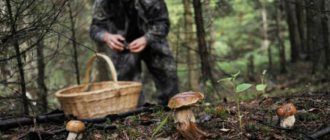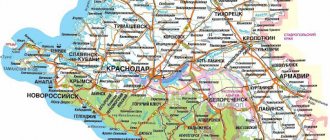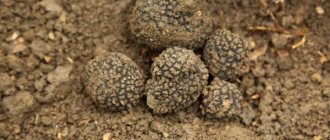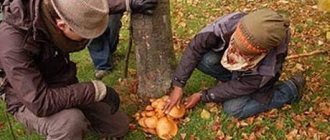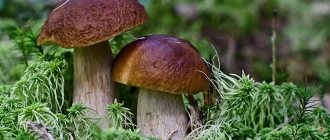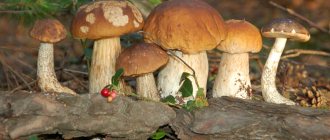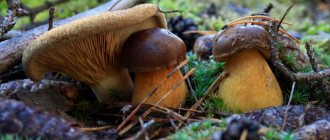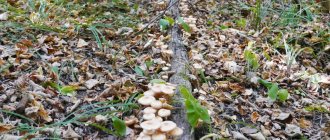The Krasnodar region is not only bright sun, beautiful nature and a warm sea, but also a place where you can collect a good harvest of mushrooms. Summer, autumn and winter honey mushrooms are considered the most popular among local residents, as they grow in large families and collection is easy and quick. Honey mushrooms in the Krasnodar region can be found in large quantities in deciduous forests from mid-July to early December. Since this species has false brothers, you need to know the external characteristics, look at photos and videos.
What types of edible honey mushrooms grow in the Krasnodar region
In the suburbs of Krasnodar you can find summer, autumn and winter varieties. In warm summers, you can harvest a good harvest, which is perfect for preparing fried, stewed and canned dishes. But since false honey mushrooms also grow in the Krasnodar region, you need to carefully familiarize yourself with the species and look at their photos.
What honey mushrooms look like in the Krasnodar region
Honey fungus is a tasty and healthy forest dweller that grows on living and rotten wood, stumps and woody substrate. Before going to the forest, you need to know the description of honey mushrooms in the Krasnodar region and study the photo:
- Autumn. Settles on rotting and living deciduous wood. They begin bearing fruit from August to October and grow in large families. They can be recognized by their convex cap and thin, long stem. The fruit body has a pleasant honey color and a light mushroom aroma. Important! Only young, not overgrown specimens are eaten.
- Bulbous. The species begins to bear fruit from August to September. Prefers to grow on deciduous trees, stumps and woody substrate. In cooking, only the caps of young specimens are used, since the flesh of the stem is hard and unsuitable for consumption.
- Summer. It grows throughout the warm season on rotting deciduous wood. You can distinguish the summer specimen from other species by the small elevation on its miniature cap and color. Young representatives have a glossy surface, colored light red.
- Winter. Can bear fruit from late October to early spring. For growth and development, the species is not afraid of sub-zero temperatures, the main thing is that it does not fall below - 10 °C. It grows everywhere: in deciduous forests, parks, squares, along reservoirs. Since the winter specimen does not have a skirt on the leg, many mushroom pickers confuse it with false species.
Since this forest dweller has inedible brothers, in order not to harm your body, you need to know some differences:
- edible forest dwellers have a pleasant aroma, while inedible ones have an earthy and unpleasant smell;
- in false species the cap is brightly colored;
- the cap of edible representatives is covered with numerous small scales;
- in noble specimens the plates are painted lemon-whitish or coffee-colored; in false specimens they are bright yellow, dirty green or gray-black.
Important! False winter species do not grow in sub-zero temperatures.
Ripening time
The peak for collecting all varieties of this mushroom occurs in late August or early autumn. Myceliums bear fruit most en masse in the first ten days of September at temperature fluctuations from 10 to 15 °C.
Irina Selyutina (Biologist):
The season for collecting honey mushrooms depends on their type:
- Spring: appear in May and bear fruit until the end of June.
- Summer: from July to the end of August.
- Autumn: they are the most popular and most desirable representatives of mushroom pickers. They are collected from the end of August to the end of October or even November. It is autumn honey mushrooms that can glow in the darkness of the night: the glow comes not only from the fruiting bodies, but also from the mycelium threads growing throughout the tree (remember the movie “Avatar”?). So, night walks in the forest can yield results - the main thing is to know the area well and not get lost. The fruiting period of autumn honey mushrooms is divided into 2-3 waves, each of which lasts in turn 2-3 weeks.
- Winter: they begin to collect them from the end of September and end in March. When severe frosts occur, all their vital processes freeze, but when the air temperature becomes even slightly above 0℃, they successfully continue to grow. Since they do not have poisonous counterparts, you can safely collect them, being absolutely confident that the crop is edible. The main thing is not to catch a cold.
They grow in two or three layers, each of which is edible for about half a month. But some species (for example, winter ones) bear fruit until March. They are easy to spot against a snowy background, but it is worth noting: they are significantly inferior in taste to their summer-autumn counterparts.
Where honey mushrooms grow in the Krasnodar region
In the suburbs of Krasnodar, mushrooms can be found in deciduous and mixed forests. To avoid leaving the forest with empty baskets, you need to know the mushroom spots.
Where does honey fungus grow in the Krasnodar region:
- A hike in the forest can be done with the onset of warm days, right up to December-January. Experienced mushroom pickers recommend exploring the Apsheronsky and Belorechensky districts, where hazel, deciduous and coniferous trees grow and where the felling areas are located.
- Since this forest dweller likes to settle in humid, fertile places, it can also be found in forests that are located along the sea coast: in the Afips Valley, near Mount Baraniy Rog, near Tuapse and in the suburbs of Gelendzhik.
- Mushroom pickers living in the suburbs of Sochi recommend exploring the forests that are located nearby: the Agur Gorge, in the village of Plastunka, in the village of Vorontsovka and next to the Zmeykovsky waterfalls.
Fragile impatiens galerina swamp
In marshy areas of the forest, in thickets of moss, you can find small mushrooms on a long thin stalk - marsh galerina. The brittle light yellow leg with a white ring at the top can be easily knocked down even with a thin twig. Moreover, the mushroom is poisonous and should not be eaten anyway. The dark yellow cap of the galerina is also fragile and watery. At a young age it looks like a bell, but then straightens, leaving only a sharp bulge in the center.
This is not a complete list of poisonous mushrooms; in addition, there are many false species that can easily be confused with edible ones. If you are not sure which mushroom is under your feet, please pass by. It’s better to take an extra lap through the forest or return home with an empty wallet than to suffer from severe poisoning later. Be careful, take care of your health and the health of those close to you!
Video about the most dangerous mushrooms for humans
Kuban is a unique region with complex terrain and a variety of climatic conditions, characteristic of several climatic zones. Thus, the mushrooms of the Krasnodar region include many known and previously unknown species, including those dangerous to human life and health. This circumstance allows us to recommend collecting exclusively well-known and guaranteed edible species.
Collection rules
In order for mushroom picking to be beneficial to health, you need to know the rules for picking.
Gifts of the forest can be taken:
- far from the highway and industrial enterprises;
- in environmentally friendly places.
Mushrooms are cut with a sharp instrument, taking care not to damage the mycelium; only young specimens are suitable for collection. Place the harvest in shallow baskets with the caps facing down. Cut mushrooms are cleaned of soil and leafy substrate.
Important! The harvested crops are immediately processed, since their shelf life is limited.
The peak of honey mushroom fruiting in the Krasnodar region is in September, so in 2022 on social networks you will be able to see wonderful mushroom places, beautiful nature, as well as delicious recipes for cooking healthy mushrooms.
Tips for lovers of mushroom delicacies
The most dangerous thing in a quiet hunt is not that a poisonous mushroom gets into the basket. It can be removed at home when the crop is sorted. The main thing is to properly prepare the harvest, otherwise poisoning may result from edible mushrooms. To prevent this from happening, you should listen to some recommendations from experienced Krasnodar mushroom pickers:
- When the harvest is delivered to the house, the product should be sorted immediately. Spoiled, broken, or mushrooms with wormholes should be removed immediately; they are unsuitable for food;
- You should absolutely not roll up canned mushrooms with metal lids. In such canned food, the botulism bacillus can develop, which damages the nervous system. The bacilli die only at a temperature of 120 degrees, and under the iron lid they only grow and multiply. Therefore, salted mushrooms are sealed only with a plastic lid;
- pickled canned food can be sealed with any lid. Vinegar, which is included in pickling, can kill any bacteria;
- All mushrooms after sorting must undergo preliminary heat treatment. But before it, it is necessary to clean each fungus from dirt, cut off the stem and rinse well in running water 2 times. Only after this should the mushrooms be cut and boiled 2 times for 20 minutes, and after the first boiling, the water is completely drained and fresh water is added.
There are some more useful tips:
Mushrooms will remain fresh for a longer period if collected in wicker baskets with holes; It is not recommended to harvest along highways and roads. In such places, mushrooms can be unsafe; here they absorb all the toxins and poisons from exhaust gases; it is best to go deeper into the forest; Only clean, strong and healthy specimens are suitable for processing for pickling, salting or drying; if it was not possible to process the product immediately, it is necessary to place it in the refrigerator; all lamellar mushrooms such as russula should be cut only with the stem
This is done so as not to confuse them with poisonous toadstools, which have “skirts” on their legs; You should never purchase canned mushrooms from unfamiliar sellers; It is not recommended to purchase mushrooms along the routes to Dzhugba and Novorossiysk; you must remember that this is unsafe for health; When purchasing mushrooms in supermarkets, you should pay attention to the quality of packaging and the integrity of the product. Don't put your health at risk
If you listen to these recommendations, mushroom delicacies will only delight you.
The most dangerous mushrooms of Kuban are fly agaric, toadstool, and plush cobweb. These mushrooms contain about 6 highly toxic substances. No heat treatment will help get rid of poisons. Therefore, in order not to accidentally collect such gifts from the forest, before a quiet hunt you should learn more about them all. And, of course, study their appearance so that they do not accidentally end up in the basket.
What honey mushrooms look like in Kuban
The species belongs in the scientific literature to the family Oryadovaceae. They are small in size with an orange or ocher color. In the Kuban, honey mushrooms can be distinguished from other mushrooms quite easily by their characteristic external features:
- the diameter of the cap in southern latitudes reaches 3-17 cm;
- the color in the center of the honey mushroom cap is darker;
- the skin of the cap has shades from honey to olive;
- the surface is scaly or rough;
- the appearance has sparse plates;
- in old specimens the flesh becomes coarser;
- the legs at the base expand and become darker;
- there is a ring on the leg that resembles a skirt;
- The length of the leg of honey mushrooms in Kuban reaches 8-10 cm.
External and taste differences are determined by the place of growth of the fruiting bodies. You need to carefully study the signs of edible species so that unsuitable specimens do not end up in the basket.
- brick red (Hypholomalateritium);
- poppy (Hypholomacapnoides);
- marginated galerina (Galerina marginata);
- sulfur yellow (Hypholomafasciculare).
This is due to the fact that old honey mushrooms also often do not have a ring, like poisonous ones.
A little about the varieties of honey mushrooms:
How to determine if a mushroom is edible or not
How to distinguish edible mushrooms from inedible ones? After all, almost everyone knows boletus mushrooms, but rare and unusual specimens are found in the forest. There are many ways. For example, as a child I had an interesting encyclopedia with pictures and descriptions, plus I always went into the forest with experienced mushroom pickers. By the way, this is the best idea to take with you into the forest a person who understands mushroom matters.
Some general tips:
- Take a closer look, if you see worms in at least one mushroom from the mycelium, they are edible.
- Tubular species are easier to distinguish from their twins.
- Study the colors, white and greenish often indicate a poisonous counterpart.
- Don't taste the mushrooms; they are not always bitter; for example, toadstool is a little sweet. Such an experiment could result in poisoning.
- A skirt is often found on false and poisonous lookalikes.
This is only a small part of the signs. Basically, each pair of doubles has its own differences
You should pay attention to the frequency of the plates at the bottom of the cap, attachment to the stem, color, pulp when cut, the presence of rings
What mushrooms grow in the vicinity of Mineralnye Vody.


